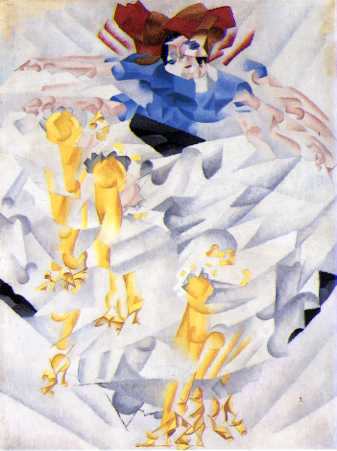![]()

http://www.unknown.nu/futurism/dynadancap.html
| |
OF THE POET--MINA LOY (1882-1966) |
|
The poet and visual artist Mina Loy has long had an underground reputation
as an exemplary avant-gardist. Born in London of mixed Jewish and English
parentage, and a much photographed beauty, she moved in the pivotal circles
of international modernism--in Florence as Gertrude Stein's friend and
Marinette's lover; in New York as Marcel Duchamp's co-conspirator and
Djuna Barnes's confidante; in Mexico with her greatest love, the notorious
boxer-poet Arthur Craven; in Paris with the Surrealists and Man
Ray. (brief intro from Becoming Modern) |
|
Her hhighly
experimental free-verse poems began appearing from 1914 on in Others,
the Dial, and The Little Review. Her most important book
of poems, Lunar Baedeker, was first published in 1923. Biting satire
and caustic cynicism expressed in savage, violent imagery are characteristic
of her verse, as in "Apology for Genius" and "Der Blinde
Jung". |
|
In 1936 she moved to New York City, which is the scene of much of her later poetry, and in 1954 to Aspen, Colorado, to be with her daughters. She died in Aspen. (the 2 excerpts from ???) |
| |
OF THE POEMS--Songs
to Joannes (1917) |
|
Songs to Joannes
is a 34 poem sequence of love songs in a characteristic impulse to conceal
while also revealing the name of [Loy's] difficult lover...While hardly
news, the idea that women desired "all the completion" of intercourse
was discussed neither in polite society nor in print. By this time [1914-16],
Mina's allusions to "mucous-membrane" and "saliva"
in "Pig Cupid" were shocking to New Yorkers, and the image
of the lover's genitalia--"Something the shape of a man"--was
scandalizing Amy Lowell, among others. (Becoming Modern, 190) |
|
Compared with the 1917 "Songs to Joannes", Lunar Baedeker's
version (retitled "Love Songs") is a resume. Most references
to Italy have been omitted, as well as clues to the lover's identities.
The tone is detached, the emphasis placed not on their skirmishes but
on the theme of romantic illusion. (Becoming Modern, 325) |
|
To sum up, Songs to Joannes is Loy's first and probably the most controversial work of poems that arouse both social "anger" and literary interest. Her experimental poetic form--the unconventional usage of diction, syntax and space--along with her paradoxical subversion of the traditional views of male-female relationship, bring new vision and possibility to the modern love and its poetry.
|
<Back>